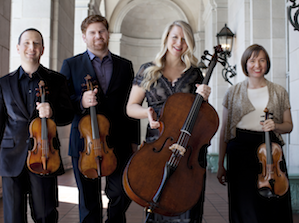
Photo by Gregory Goode
The Cypress String Quartet presented a program of interrelated composers last weekend in San Francisco, titled “Slavic Soundscapes.” What do Dmitri Shostakovich, Benjamin Britten, and Benjamin Lees have in common? Britten and Shostakovich were cross-cultural buddies who supported each other’s music on either side of the Iron Curtain at the height of the Cold War. Britten was also a friend of the Russian-American composer Benjamin Lees, as well as a champion of his music. The Cypress commissioned music and spent time with Lees. In addition, they studied with the Amadeus Quartet, which premiered Britten’s string quartets, working with him up until his death. Sometimes the classical music world feels very small.
The close personal connections were clearly heard in the music performed. All three works had stylistic elements in common: the glissando (sliding the finger up and down the string) had an important role; polytonal counterpoint was used with triads as an element of the vocabulary but not the only element; magical textures were set under unusual melodies; and a sense of humor was present even when the subject matter is dark. Cypress Quartet second violinist Tom Stone described this quality as “sardonic” — as if all the composers were in on a private joke. As is their custom, Quartet members took turns delivering minilectures about the repertoire. All of them are eloquent speakers, providing historical context about the music they are about to perform and also tying in personal anecdotes about their rehearsal process and behind-the-scenes inspiration.
Shostakovich’s Quartet No. 11 in F Major, Op. 122, opened the program. His dry Russian wit was evident, despite the work’s being dedicated to a member of the Beethoven Quartet who had recently died. The Cypress played with a gripping intensity that tracked the narrative through seven diverse movements. The crazy “Étude” section was extra-riveting, with first violinist Cecily Ward delivering the torrent of blustering fast notes with clarity and precision while the rest of the quartet hummed in ghostly melodies around her.
Britten’s String Quartet No. 3, Op. 94, pushes the limits of harmony and extended technique, yet its “special effects” are more than mere effects — they are an expressive part of the music. Violist Ethan Filner played fast swipes behind the bridge — a technique that usually produces scratchy, unpleasant sounds but that here resonated with the harmony and created a pleasant tinkling noise as well as a playful atmosphere.
Lees’ String Quartet No. 5 (2001) is a piece full of imagination, a true fountain of ideas.
Benjamin Lees had a close relationship with the Cypress Quartet, which even commissioned a quartet from him and recorded his works. Since he died in 2010, the Quartet has continued its dedication to his music. His String Quartet No. 5 (2001) is a piece full of imagination, a true fountain of ideas. Cellist Jennifer Kloetzel described the composer’s excitement when he came up with a new movement — a scherzo section in which dizzying scale patterns are buzzed back and forth in blurry speed. Kloetzel also talked about Lees’ surrealist approach; the composer would berate them when they would try to make “logical” sense out of things.
It was most refreshing to hear a concert without 18th- or 19th-century music on the program. I love classical and Romantic as much as anybody, but the disproportionate representation of those eras is getting tiresome, and I find that I get a totally different kind of spiritual fulfillment hearing composers that I don’t know as well.
The concert was held at the new SFJazz Center, which feels fresh and trendy. Its Joe Henderson Lab is a very intimate space — so much so that audience members were rubbing knees with their neighbors and could hear each other breathe (awkward!). Floor-to-ceiling windows looking onto bustling Franklin Street in the Civic Center area give the space a cool urban vibe, though it was a bit distracting (even with curtains lowered) as pedestrians peeked in curiously from the sidewalk. The hall is dry; the sound is absorbed by the ribbed walls, carpet, people, curtains, and super-soundproof glass (a fire truck from a nearby station went by with sirens blaring but was barely audible).
String quartets need some kind of natural reverberation from the hall; artists require multiple reflections to blend their sound.
In the lab space, there are practically no natural sound reflections. An attempt was made to ameliorate this with artificial reverb. It sounded good, yet there is no way that a room like this could generate such an actual echo — so it felt fake. At first I thought the door was open and I was hearing an echo from the lobby. String quartets need some kind of natural reverberation from the hall; artists require multiple reflections to blend their sound. As one plus for such a small and dry space, every single detail was audible, ranging from the sound of the bow hair scraping across the strings in pianissimo sections to breath cues. The close quarters tightened the relationship between performers and listeners, creating an intense concert experience.

